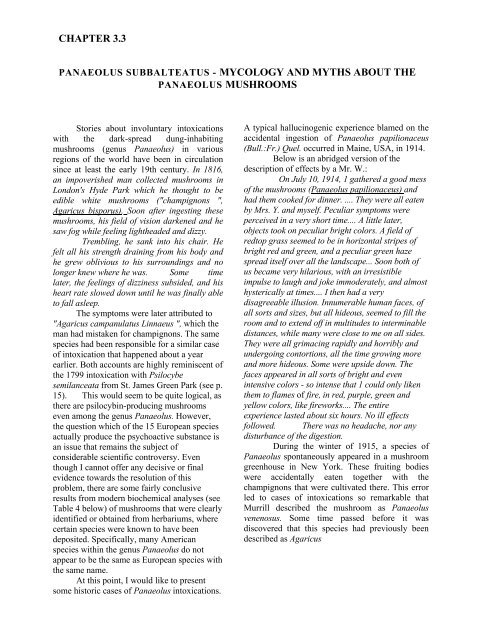Jochen Gartz - Magic Mushrooms Around the ... - preterhuman.net
Jochen Gartz - Magic Mushrooms Around the ... - preterhuman.net
Jochen Gartz - Magic Mushrooms Around the ... - preterhuman.net
Create successful ePaper yourself
Turn your PDF publications into a flip-book with our unique Google optimized e-Paper software.
CHAPTER 3.3<br />
PANAEOLUS SUBBALTEATUS - MYCOLOGY AND MYTHS ABOUT THE<br />
PANAEOLUS MUSHROOMS<br />
Stories about involuntary intoxications<br />
with <strong>the</strong> dark-spread dung-inhabiting<br />
mushrooms (genus Panaeolus) in various<br />
regions of <strong>the</strong> world have been in circulation<br />
since at least <strong>the</strong> early 19th century. In 1816,<br />
an impoverished man collected mushrooms in<br />
London's Hyde Park which he thought to be<br />
edible white mushrooms ("champignons ",<br />
Agaricus bisporus). Soon after ingesting <strong>the</strong>se<br />
mushrooms, his field of vision darkened and he<br />
saw fog while feeling ligh<strong>the</strong>aded and dizzy.<br />
Trembling, he sank into his chair. He<br />
felt all his strength draining from his body and<br />
he grew oblivious to his surroundings and no<br />
longer knew where he was. Some time<br />
later, <strong>the</strong> feelings of dizziness subsided, and his<br />
heart rate slowed down until he was finally able<br />
to fall asleep.<br />
The symptoms were later attributed to<br />
"Agaricus campanulatus Linnaeus ", which <strong>the</strong><br />
man had mistaken for champignons. The same<br />
species had been responsible for a similar case<br />
of intoxication that happened about a year<br />
earlier. Both accounts are highly reminiscent of<br />
<strong>the</strong> 1799 intoxication with Psilocybe<br />
semilanceata from St. James Green Park (see p.<br />
15). This would seem to be quite logical, as<br />
<strong>the</strong>re are psilocybin-producing mushrooms<br />
even among <strong>the</strong> genus Panaeolus. However,<br />
<strong>the</strong> question which of <strong>the</strong> 15 European species<br />
actually produce <strong>the</strong> psychoactive substance is<br />
an issue that remains <strong>the</strong> subject of<br />
considerable scientific controversy. Even<br />
though I cannot offer any decisive or final<br />
evidence towards <strong>the</strong> resolution of this<br />
problem, <strong>the</strong>re are some fairly conclusive<br />
results from modern biochemical analyses (see<br />
Table 4 below) of mushrooms that were clearly<br />
identified or obtained from herbariums, where<br />
certain species were known to have been<br />
deposited. Specifically, many American<br />
species within <strong>the</strong> genus Panaeolus do not<br />
appear to be <strong>the</strong> same as European species with<br />
<strong>the</strong> same name.<br />
At this point, I would like to present<br />
some historic cases of Panaeolus intoxications.<br />
A typical hallucinogenic experience blamed on <strong>the</strong><br />
accidental ingestion of Panaeolus papilionaceus<br />
(Bull.:Fr.) Quel. occurred in Maine, USA, in 1914.<br />
Below is an abridged version of <strong>the</strong><br />
description of effects by a Mr. W.:<br />
On July 10, 1914, 1 ga<strong>the</strong>red a good mess<br />
of <strong>the</strong> mushrooms (Panaeolus papilionaceus) and<br />
had <strong>the</strong>m cooked for dinner. .... They were all eaten<br />
by Mrs. Y. and myself. Peculiar symptoms were<br />
perceived in a very short time.... A little later,<br />
objects took on peculiar bright colors. A field of<br />
redtop grass seemed to be in horizontal stripes of<br />
bright red and green, and a peculiar green haze<br />
spread itself over all <strong>the</strong> landscape... Soon both of<br />
us became very hilarious, with an irresistible<br />
impulse to laugh and joke immoderately, and almost<br />
hysterically at times.... I <strong>the</strong>n had a very<br />
disagreeable illusion. Innumerable human faces, of<br />
all sorts and sizes, but all hideous, seemed to fill <strong>the</strong><br />
room and to extend off in multitudes to interminable<br />
distances, while many were close to me on all sides.<br />
They were all grimacing rapidly and horribly and<br />
undergoing contortions, all <strong>the</strong> time growing more<br />
and more hideous. Some were upside down. The<br />
faces appeared in all sorts of bright and even<br />
intensive colors - so intense that 1 could only liken<br />
<strong>the</strong>m to flames of fire, in red, purple, green and<br />
yellow colors, like fireworks.... The entire<br />
experience lasted about six hours. No ill effects<br />
followed. There was no headache, nor any<br />
disturbance of <strong>the</strong> digestion.<br />
During <strong>the</strong> winter of 1915, a species of<br />
Panaeolus spontaneously appeared in a mushroom<br />
greenhouse in New York. These fruiting bodies<br />
were accidentally eaten toge<strong>the</strong>r with <strong>the</strong><br />
champignons that were cultivated <strong>the</strong>re. This error<br />
led to cases of intoxications so remarkable that<br />
Murrill described <strong>the</strong> mushroom as Panaeolus<br />
venenosus. Some time passed before it was<br />
discovered that this species had previously been<br />
described as Agaricus








![The Big Lie 9-11 and Government Complicity in Mass Murder [PDF]](https://img.yumpu.com/50957077/1/190x245/the-big-lie-9-11-and-government-complicity-in-mass-murder-pdf.jpg?quality=85)








